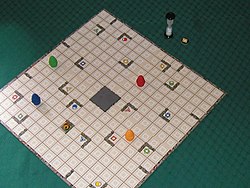Frenzied robots
| Frenzied robots | |
|---|---|
 Racing robots game plan |
|
| Game data | |
| author | Alex Randolph |
| graphic | Franz Vohwinkel |
| publishing company |
Hans im Glück (1999), Abacus Games (2004), Rio Grande Games (1999, 2004), Abacus Games (2013) |
| Publishing year | 1999, 2004, 2013 |
| Art | Board game |
| Teammates | starting at 2 |
| Duration | 45-60 minutes |
| Age | from 10 years on |
Frenzied Robots is the name of a board game by Alex Randolph .
The game was published in Germany in 1999 by Hans im Glück Verlag . From 2004 two new editions were published by Abacusspiele . The English edition was published by Rio Grande Games as Ricochet Robot in 1999 and as Ricochet Robots in 2004 . In 2013, Abacusspiele published a new, more complex edition in Germany under the name Ricochet Robots . The game is designed for players aged 10 and over and lasts around 45 minutes, although the publisher has specified a playing time of 30 minutes since 2013.
Furnishing
The game plan originally consisted of four quarters printed on both sides, so that there were 96 different possible combinations. Eight double-sided quarters have been in play since 2013, so that arithmetically 1536 variants of the game board are possible. 4 figures (robots) move on this board. There are also 17 chips and an hourglass.
Game flow
Frenzied robots is a puzzle game for two or more participants; there is no limit to the number of players. The four different colored robots are randomly distributed on the game board. Then one of the 17 chips is turned over. With the exception of a colored chip, each chip has a symbol and a colored background, which corresponds exactly to a field on the game board. Now every player has to find a way to get the robot of the same color onto that square with as few moves as possible. Each of the four colored robots has to be moved to four different fields during the game. There is also a colored field to which any robot can be moved. The robots only move horizontally or vertically across the game board and only stop when they hit an obstacle, either a wall on the game board or one of the other robots. The three different colored robots can also be moved in order to use them as an obstacle. If another player has found a way, he states the number of moves he needs to do it and turns the hourglass. Until the end of the hourglass, all players have the opportunity to name the number of moves of their solution. As soon as the hourglass has expired, the player who named the lowest number shows his solution. If he brings the robot to the target field with the specified number of moves, he receives the chip. Otherwise the player who named the second lowest number gets his chance, etc.
An additional variant since the 2004 edition is to include a fifth, initially silver and, since 2013, black robot in the game. This can only be used as an obstacle for the other robots or to be dragged onto the colored field.
In the 2013 edition, diagonal barriers in the four colors are printed on some of the game boards. The robots of the same color are just going through these, while all robots of different colors are reflected at an angle to the next barrier, both counting as one move.
Playing
Are all 17 chips dealt, i. H. Solved all 17 tasks, so the player with the most chips wins. Since 2013 6 chips are sufficient for 3 players and 5 chips for 4 players.
Complexity-theoretical consideration
As was shown in 2005, the question of whether a solution for any robot exists for a given field, given number of robots and given start configuration is NP-difficult (see web links).
expenditure
The first edition appeared in 1999 under the name Rasende Roboter by Hans im Glück Verlag . This edition is no longer available and is still very popular with collectors. An English and identical version was published by Rio Grande Games as Ricochet Robot that same year .
The second edition was published in 2004 by Rio Grande Games under the name Ricochet Robots and distributed in Germany by Abacusspiele . This version contains a fifth robot (black) and has additional elements on the game board. This edition is no longer produced and is rarely available. You can recognize it by the blue box.
In 2008, Rio Grande Games published the third edition under the name Ricochet Robots , the schedule of which is identical to the original version. This edition will continue to be distributed by Abacusspiele in Germany and can be recognized by the wine-red box and a corresponding imprint in the lower left corner. It contains an additional silver robot that can be used for different game variants.
In the edition since 2013, which is now also being sold in Germany by Abacusspiele as Ricochet Robots , the additional robot is black and contains eight double-sided elements of the playing field. The black robot can only be used as an obstacle with 16 of the target chips, only if the swirl of color is the target, it can also run to the target.
Web links
- Rasende Robots (1999) in the Luding games database
- Ricochet Robot (1999) in the Luding games database
- Ricochet Robots (2004) in the Luding games database
- Ricochet Robert (2013) in the Luding games database
- Ricochet Robots in the game database BoardGameGeek (English)
- The very fast solution program yarr
- Another solution program DriftingDroids
- informatik.uni-bonn.de: Randolph's Robot Game is NP-hard! (PDF; 218 kB)